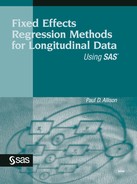2.1. Introduction
In chapter 1, I showed how the conventional paired-comparisons t-test could be interpreted as a fixed effects method that controlled for all stable characteristics of the individual. The model discussed there was actually a special case of a more general linear model for quantitative response variables. That model is the subject of this chapter.
First some notation. Let yit be the value of the response variable for individual i on occasion t. To keep things concrete, I'll refer to the individuals as persons and the occasions as different times at which the person is measured. However, in some applications i could index groups and t could index different individuals within those groups.
We also have some predictor variables: zi is a column vector of variables that describe persons but do not vary over time; xit is a column vector of variables that vary both over individuals and over time for each individual. (If you're not comfortable with vectors, you can read these as single variables). The basic model that we will use is
In this equation μt is an intercept that is allowed to vary with time, β and γ are row vectors of coefficients, and εit is a random disturbance term. As in chapter 1, αi represents all differences between persons that are stable over time and not otherwise accounted for by γzi. In a fixed effects model, we regard these as fixed parameters, one per person. That implies that xit may be correlated with αi.
As in the conventional linear model, we assume that εit has a mean of 0, that it has constant variance, and that cov(εit, εjt) = 0 for i ¬ j. Unlike conventional linear regression, we do not require that εit be uncorrelated with zi or αi. On the other hand, the assumptions about the relationship between εit and xit are somewhat stronger than usual. Specifically, for the methods used in this chapter, we assume that xit is strictly exogenous, which means that xit at any time t is statistically independent of the random disturbances at all points in time, not just at time t. The most important aspect of this assumption is that xit cannot depend on y at earlier points in time. In chapter 6, however, we shall relax this assumption to allow for reciprocal relationships between the two variables.
Under these assumptions, equation (2.1) can be optimally estimated by ordinary least squares (OLS). However, depending in part on the structure of the data, there are a variety of ways to implement OLS for the fixed effects model and a number of special considerations that need to be addressed. Let's first see how to do it in the relatively simple situation in which each individual has exactly two measurements on both the response variable and the time-varying predictor variables.
